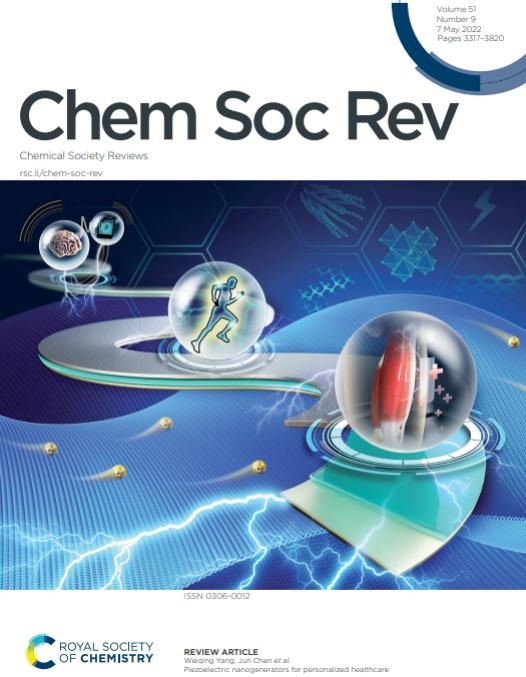太阳能驱动整体水分解的新型无机-有机杂化光催化剂:进展与展望。
IF 39
1区 化学
Q1 CHEMISTRY, MULTIDISCIPLINARY
引用次数: 0
摘要
长期以来,对可持续能源技术的追求激发了高效光催化剂的开发,这些光催化剂能够通过整体水(H2O)分解将太阳能转化为氢(H2)。虽然无机半导体,如金属氧化物、氮氧化物和硫化物,已经证明了合理的活性和稳健性,但它们在光收集和电荷分离方面的固有局限性继续阻碍着它们的光催化性能。相反,有机半导体具有引人注目的优势,包括可调谐的电子结构、可见光吸收和合成的多功能性。然而,激子扩散长度短,载流子迁移率低,多电子过程活性差,限制了它们在整体H2O分裂中的应用。最近,将有机和无机材料集成到混合光催化剂中已经成为克服这些瓶颈的有力策略。通过将无机骨架的高效电荷输运与有机材料的结构适应性和光电可调性协同结合,合理设计的杂化体系在提高光利用率、促进激子解离和抑制复合方面显示出显著的潜力。这些进展不仅提高了整体的水裂解效率,而且为光催化剂的设计开辟了新的途径。本文综述了用于太阳能驱动的整体水裂解的无机-有机杂化光催化剂的基本原理、界面相互作用和光物理机制。我们强调了最新的突破,分析了剩余的科学和工程挑战,并提出了具有更高可扩展性,效率和耐用性的下一代混合系统的战略方向。我们的目标是建立一个具有前瞻性的路线图,定义混合光催化剂作为实现可持续、碳中和社会的变革平台的作用。本文章由计算机程序翻译,如有差异,请以英文原文为准。
Emerging inorganic-organic hybrid photocatalysts for solar-driven overall water splitting: progress and perspectives.
The pursuit of sustainable energy technologies has long inspired the development of efficient photocatalysts capable of converting solar energy into hydrogen (H2) via overall water (H2O) splitting. While inorganic semiconductors, such as metal oxides, oxynitrides, and oxysulfides, have demonstrated reasonable activity and robustness, their intrinsic limitations in light harvesting and charge separation continue to hinder their photocatalytic performance. Conversely, organic semiconductors offer compelling advantages, including tunable electronic structures, visible-light absorption, and synthetic versatility. However, their application in overall H2O splitting remains constrained by short exciton diffusion lengths, low carrier mobility, and poor activity in multi-electron processes. Recently, integrating organic and inorganic materials into hybrid photocatalysts has emerged as a powerful strategy to overcome these bottlenecks. By synergistically combining the efficient charge transport of inorganic frameworks with the structural adaptability and optoelectronic tunability of organic materials, rationally designed hybrid systems have shown remarkable potential in enhancing light utilization, facilitating exciton dissociation, and suppressing recombination. These advances not only improve overall H2O splitting efficiency but also open new avenues for photocatalyst design. This review critically examines the fundamental principles, interfacial interactions, and photophysical mechanisms underpinning inorganic-organic hybrid photocatalysts for solar-driven overall H2O splitting. We highlight recent breakthroughs, analyse the remaining scientific and engineering challenges, and propose strategic directions for next-generation hybrid systems with improved scalability, efficiency, and durability. Our goal is to establish a forward-looking roadmap that defines the role of hybrid photocatalysts as a transformative platform in achieving a sustainable, carbon-neutral society.
求助全文
通过发布文献求助,成功后即可免费获取论文全文。
去求助
来源期刊

Chemical Society Reviews
化学-化学综合
CiteScore
80.80
自引率
1.10%
发文量
345
审稿时长
6.0 months
期刊介绍:
Chemical Society Reviews is published by: Royal Society of Chemistry.
Focus: Review articles on topics of current interest in chemistry;
Predecessors: Quarterly Reviews, Chemical Society (1947–1971);
Current title: Since 1971;
Impact factor: 60.615 (2021);
Themed issues: Occasional themed issues on new and emerging areas of research in the chemical sciences
 求助内容:
求助内容: 应助结果提醒方式:
应助结果提醒方式:


